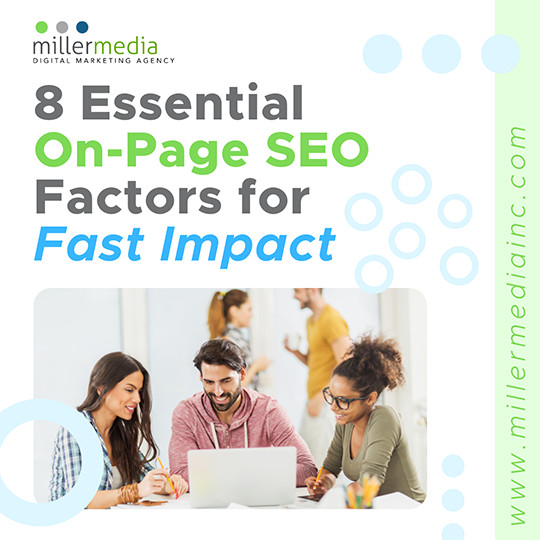Optimize your website for a better user experience and give Google a clearer understanding of your content with on-page SEO. This will help your Google ranking and quicken the increase in web traffic. Begin with pages you want more potential clients to visit and audit them to discover what on-page SEO elements you need to add, change, improve, or remove. Not sure what on-page elements to look for? Here 8 elements and factors to keep eye on:
1. Title Tags
Title tags appear within the search engine result below the URL and above the meta description. Create on-brand and eye-catching titles with optimized keywords. Target 51-55 characters for the best odds that Google won’t rewrite your title tags. Try to use the language of your target audience with an exact-match keyword. Make sure it matches the intent of your audience. Also make sure it is descriptive of the content because if inaccurate your bounce rate will increase instead of decreasing. An example of an effective title tag might be if a manufacturing company searches “web design near me and your title reads “Stunning Websites for the Industrial Market”.
2. Detailed Snappy Headings
Putting target keywords in page headings and subheadings is a simple, but a surprisingly forgotten way to optimize your page’s search results. Your H1 should be crafty, compelling, clear, concise, and front-loaded with keywords to draw your target audience into the main content. Utilizing descriptive keywords in your H2s and H3s is also a great way to break up long content, making it easier for the user to find what they are looking for. Any and every type of page can benefit from optimizing subheadings, including templatized pages like ecommerce product detail page and other standardized listings, not just information websites.
3. Rich Content (no matter the length)
On Page SEO relies on semantic search and natural language processing. Great content should answer the query, anticipate the user’s next questions, and answer those in advance. Make the most of shorter content by being intentional with every word. Make sure your content is rich with terms semantically related to your target keyword. Try swapping out pronouns like “it” for words that are more descriptive. Make sure your writing is easy to read by people and machines. Resist fragments and run-on sentences.
4. Internal Links with Optimized Anchor Text
Internal links are easy high impact on-page SEO optimization. It anchors text to a destination page and facilitates a path to purchase. Optimize anchor text with your target keywords or semantic terms. Also choose link placement wisely because links with related content will reap more benefit to your target landing page.
5. E-A-T Signals
E-A-T is a way Google measures the value of your content and stands for Expertise, Authoritativeness, and Trustworthiness. Add high-quality external citations to informational content, long-form articles and other sources with an author that is reputable. E-A-T signals are not only there for users but for quality Raters, awards, testimonials, and studies that can all add value for your target audience. Establishing beneficial purpose and demonstrating trustworthiness is important for rankings, conversion, and thus overall lead generation. Visitors are more likely to choose to company that looks like they know what they are talking about vs one with no expert opinion.
6. FAQs & “People Also Ask” Content
Research on SERPs and the People Also Ask (PAA) box based on your target audience. PAA allows Google to increase the number featured on Snippets, which means answering an important question will increase the chance on SERP longevity. Target PAA that have weak answers that can be improved upon. If the current PAA results are accurate and you don’t expect to unseat the current ranking page, you should still incorporate these questions in your content to be seen as an authority. Directly ask the relevant questions in subheadings and answering in list or paragraph format as appropriate. For long form articles, put this directly in an H2. For ecommerce pages, create a dedicated FAQ section.
7. Descriptive Image Alt Text
Make sure your alt text is optimized and falls into the “truly essential” grouping. Descriptive alt text is always critical for visually impaired users, especially if they rely on a e-reader. This does not only apply to photos, but infographic as other flat images as well. Google and other search engines value descriptions due to its ability to target a wide range of users.
8. Valid Schema Markup
Schema Markup is a collection of code snippets that can be placed on any page of a website. It is used to call out specific aspects of the page in the search results. Pages with structured data tend to receive higher click-through rates than those without, as the snippets are more engaging and attractive to searchers. A good example are recipes. Google any recipe and the top will show a photo, link, rating, time, and mini description of the subject. This is very important to ecommerce business as it will entice more users to click on your partner.
Need help with your on-page SEO strategy? Call 248.528.360

